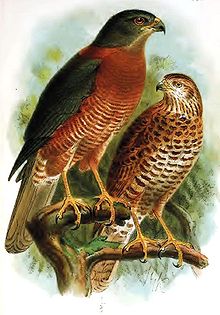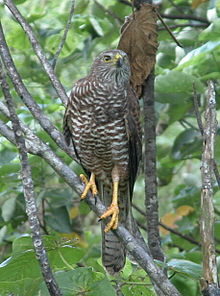- Christmas Goshawk
-
Christmas Goshawk 
Conservation status Scientific classification Kingdom: Animalia Phylum: Chordata Class: Aves Order: Falconiformes (or Accipitriformes, q.v.) Family: Accipitridae Genus: Accipiter Species: A. fasciatus Subspecies: A. f. natalis Trinomial name Accipiter fasciatus natalis
(Lister, 1889)Synonyms - Accipiter natalis
- Accipiter novaehollandiae natalis
- Accipiter hiogaster natalis
The Christmas Goshawk or Christmas Island Goshawk (Accipiter fasciatus natalis) is a bird of prey in the goshawk and sparrowhawk family Accipitridae. It is a threatened endemic of Christmas Island, an Australian territory in the eastern Indian Ocean.
Contents
Taxonomy
The taxon was described in 1889 by Lister as a full species, Accipiter natalis. Since then there has been debate as to whether its affinities lie with the Brown Goshawk or the Grey Goshawk (A. novaehollandiae). In the 2004 national recovery plan for the taxon it is treated as a subspecies of the Brown Goshawk, though the possibility has been raised of elevating it to the species level again.[1] Christidis and Boles (2008) treat it as a subspecies of the Variable Goshawk (A. hiogaster).[2] Here it is treated as a subspecies of the Brown Goshawk pending further study of its genome.
Description
The Christmas Goshawk is smaller and has more rounded wings than the nominate subspecies. Colouration is broadly similar, differing in that the hindneck, cap and ear coverts are dark grey, lacking a brown tinge. Females are distinctly larger than males.[3]
Distribution and habitat
The goshawk is restricted to the 135 km2 Christmas Island where it is found in the tropical rainforest that covers 75% of the island, as well as in other habitats there such as regrowth forest and the edges of clearings.[4]
Behaviour
Breeding
The goshawk builds nests high in tall forest trees. Until it's time to breed, this species of Goshawk live solitarily. They breed from August to January, during which the mates will be reunited, and will fly and call in unison.[5]
Feeding
The goshawk feeds on a wide range of vertebrates and invertebrates, including birds, mammals, reptiles and insects. It takes its prey from the ground or in flight. It will hunt from a perch or chase birds through the forest.[6]
Status and conservation
The goshawk is listed as endangered under the Environment Protection and Biodiversity Conservation Act 1999. There are no detailed population statistics for the goshawks, though the population is small and it has been estimated that there are no more than 100 mature birds, or 50 breeding pairs, on the island.[7] The principal threat comes from yellow crazy ants which were accidentally introduced to the island. The threat is not only that of ant predation of goshawk nestlings, but also indirectly from potentially massive changes to the ecology of the island caused by the ants.[8]
Notes
References
- Christidis, Les; & Boles, Walter E. (2008). Systematics and taxonomy of Australian birds. CSIRO Publishing: Melbourne. ISBN 9780643065116
- Garnett, Stephen T.; & Crowley, Gabriel M. (2000). The Action Plan for Australian Birds 2000. Environment Australia: Canberra. ISBN 0-642-54683-5 [1]
- Hill, Richard. (2004). National recovery plan for the Christmas Island Goshawk Accipiter fasciatus natalis. Dept of the Environment and Heritage: Canberra. ISBN 0-642-55009-3.[2]
- Marchant, S.; Higgins, P.J.; & Davies, J.N. (eds). (1994). Handbook of Australian, New Zealand and Antarctic Birds. Volume 2: Raptors to Lapwings. Oxford University Press: Melbourne. ISBN 0-19-553069-1
External links
Categories: EPBC Act endangered biota | Birds of Australia | Fauna of Christmas Island | Accipiter | Animals described in 1889
Wikimedia Foundation. 2010.


